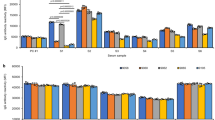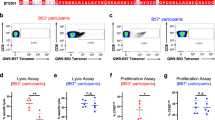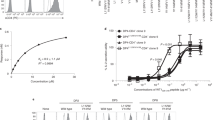Abstract
HA-1H is one of the most attractive minor histocompatibility antigens (mHA) as a target for immunotherapy of hematopoietic malignancies, but HLA-A*0201 and HLA-B60 molecules capable of presenting HA-1H-derived peptides are less common in eastern Asian populations when compared with Caucasian populations. Therefore, an attempt was made to search for novel epitopes presented by HLA alleles other than those previously reported by generating CTL lines from patients undergoing HLA-identical, HA-1 disparate hematopoietic stem cell transplantation (hematopoietic SCT) by stimulation with a 29-mer HA-1H peptide spanning a central polymorphic histidine (His). Two CTL clones established were found to be restricted by HLA-A*0206, which is the second or third most common HLA-A2 subtype worldwide. Epitope mapping revealed that the clones recognized the same nonameric peptide as A*0201-restricted HA-1H, VLHDDLLEA. This epitope was unexpected, since it does not contain any preferred anchor motifs for HLA-A*0206. However, an HLA peptide binding assay revealed stronger binding of this peptide to A*0206 than to A*0201. Interestingly, HLA-A*0206-restricted CTL clones could lyse both HLA-A*0206+ and HLA-A*0201+ targets (including leukemic blasts) that express HA-1H peptide endogenously, whereas an HLA-A*0201-restricted, HA-1H-specific CTL clone failed to lyse HLA-A*0206+ targets. This finding will expand the patient population who can benefit from HA-1H-based immunotherapy.
This is a preview of subscription content, access via your institution
Access options
Subscribe to this journal
Receive 12 print issues and online access
$259.00 per year
only $21.58 per issue
Buy this article
- Purchase on Springer Link
- Instant access to full article PDF
Prices may be subject to local taxes which are calculated during checkout



Similar content being viewed by others
References
Goulmy E . Human minor histocompatibility antigens. Curr Opin Immunol 1996; 8: 75–81.
Simpson E, Roopenian D . Minor histocompatibility antigens. Curr Opin Immunol 1997; 9: 655–661.
den Haan JM, Meadows LM, Wang W, Pool J, Blokland E, Bishop TL et al. The minor histocompatibility antigen HA-1: a diallelic gene with a single amino acid polymorphism. Science 1998; 279: 1054–1057.
Mutis T, Verdijk R, Schrama E, Esendam B, Brand A, Goulmy E . Feasibility of immunotherapy of relapsed leukemia with ex vivo-generated cytotoxic T lymphocytes specific for hematopoietic system-restricted minor histocompatibility antigens. Blood 1999; 93: 2336–2341.
Mommaas B, Kamp J, Drijfhout JW, Beekman N, Ossendorp F, Van Veelen P et al. Identification of a novel HLA-B60-restricted T cell epitope of the minor histocompatibility antigen HA-1 locus. J Immunol 2002; 169: 3131–3136.
den Haan JM, Sherman NE, Blokland E, Huczko E, Koning F, Drijfhout JW et al. Identification of a graft versus host disease-associated human minor histocompatibility antigen. Science 1995; 268: 1476–1480.
Pierce RA, Field ED, Mutis T, Golovina TN, Von Kap-Herr C, Wilke M et al. The HA-2 minor histocompatibility antigen is derived from a diallelic gene encoding a novel human class I myosin protein. J Immunol 2001; 167: 3223–3230.
Akatsuka Y, Nishida T, Kondo E, Miyazaki M, Taji H, Iida H et al. Identification of a polymorphic gene, BCL2A1, encoding two novel hematopoietic lineage-specific minor histocompatibility antigens. J Exp Med 2003; 197: 1489–1500.
Nishida T, Akatsuka Y, Morishima Y, Hamajima N, Tsujimura K, Kuzushima K et al. Clinical relevance of a newly identified HLA-A24-restricted minor histocompatibility antigen epitope derived from BCL2A1, ACC-1, in patients receiving HLA genotypically matched unrelated bone marrow transplant. Br J Haematol 2004; 124: 629–635.
Dolstra H, Fredrix H, Maas F, Coulie PG, Brasseur F, Mensink E et al. A human minor histocompatibility antigen specific for B cell acute lymphoblastic leukemia. J Exp Med 1999; 189: 301–308.
Dolstra H, de Rijke B, Fredrix H, Balas A, Maas F, Scherpen F et al. Bi-directional allelic recognition of the human minor histocompatibility antigen HB-1 by cytotoxic T lymphocytes. Eur J Immunol 2002; 32: 2748–2758.
Brickner AG, Evans AM, Mito JK, Xuereb SM, Feng X, Nishida T et al. The PANE1 gene encodes a novel human minor histocompatibility antigen that is selectively expressed in B-lymphoid cells and B-CLL. Blood 2006; 107: 3779–3786.
Date Y, Kimura A, Kato H, Sasazuki T . DNA typing of the HLA-A gene: population study and identification of four new alleles in Japanese. Tissue Antigens 1996; 47: 93–101.
Fernandez-Vina MA, Falco M, Sun Y, Stastny P . DNA typing for HLA class I alleles: I. Subsets of HLA-A2 and of -A28. Hum Immunol 1992; 33: 163–173.
Parham P, Lawlor DA, Lomen CE, Ennis PD . Diversity and diversification of HLA-A,B,C alleles. J Immunol 1989; 142: 3937–3950.
Atanackovic D, Matsuo M, Ritter E, Mazzara G, Ritter G, Jager E et al. Monitoring CD4+ T cell responses against viral and tumor antigens using T cells as novel target APC. J Immunol Methods 2003; 278: 57–66.
Shimizu Y, Geraghty DE, Koller BH, Orr HT, DeMars R . Transfer and expression of three cloned human non-HLA-A,B,C class I major histocompatibility complex genes in mutant lymphoblastoid cells. Proc Natl Acad Sci USA 1988; 85: 227–231.
Akatsuka Y, Goldberg TA, Kondo E, Martin EG, Obata Y, Morishima Y et al. Efficient cloning and expression of HLA class I cDNA in human B-lymphoblastoid cell lines. Tissue Antigens 2002; 59: 502–511.
Riddell SR, Greenberg PD . The use of anti-CD3 and anti-CD28 monoclonal antibodies to clone and expand human antigen-specific T cells. J Immunol Methods 1990; 128: 189–201.
Sylvester-Hvid C, Kristensen N, Blicher T, Ferre H, Lauemoller SL, Wolf XA et al. Establishment of a quantitative ELISA capable of determining peptide–MHC class I interaction. Tissue Antigens 2002; 59: 251–258.
Kuzushima K, Hayashi N, Kudoh A, Akatsuka Y, Tsujimura K, Morishima Y et al. Tetramer-assisted identification and characterization of epitopes recognized by HLA A*2402-restricted Epstein–Barr virus-specific CD8+ T cells. Blood 2003; 101: 1460–1468.
Akatsuka Y, Martin EG, Madonik A, Barsoukov AA, Hansen JA . Rapid screening of T-cell receptor (TCR) variable gene usage by multiplex PCR: application for assessment of clonal composition. Tissue Antigens 1999; 53: 122–134.
van der Veken LT, Hoogeboom M, de Paus RA, Willemze R, Falkenburg JH, Heemskerk MH . HLA class II restricted T-cell receptor gene transfer generates CD4+ T cells with helper activity as well as cytotoxic capacity. Gene Ther 2005; 12: 1686–1695.
Folch G, Lefranc MP . The human T cell receptor beta variable (TRBV) genes. Exp Clin Immunogenet 2000; 17: 42–54.
Sudo T, Kamikawaji N, Kimura A, Date Y, Savoie CJ, Nakashima H et al. Differences in MHC class I self peptide repertoires among HLA-A2 subtypes. J Immunol 1995; 155: 4749–4756.
Falk K, Rotzschke O, Stevanovic S, Jung G, Rammensee HG . Allele-specific motifs revealed by sequencing of self-peptides eluted from MHC molecules. Nature 1991; 351: 290–296.
Goulmy E, Pool J, van den Elsen PJ . Interindividual conservation of T-cell receptor beta chain variable regions by minor histocompatibility antigen-specific HLA-A*0201-restricted cytotoxic T-cell clones. Blood 1995; 85: 2478–2481.
Verdijk RM, Mutis T, Wilke M, Pool J, Schrama E, Brand A et al. Exclusive TCRVbeta chain usage of ex vivo generated minor Histocompatibility antigen HA-1 specific cytotoxic T cells: implications for monitoring of immunotherapy of leukemia by TCRBV spectratyping. Hematol J 2002; 3: 271–275.
Miyazaki M, Akatsuka Y, Nishida T, Fujii N, Hiraki A, Ikeda K et al. Potential limitations in using minor histocompatibility antigen-specific cytotoxic T cells for targeting solid tumor cells. Clin Immunol 2003; 107: 198–201.
Klein CA, Wilke M, Pool J, Vermeulen C, Blokland E, Burghart E et al. The hematopoietic system-specific minor histocompatibility antigen HA-1 shows aberrant expression in epithelial cancer cells. J Exp Med 2002; 196: 359–368.
Marijt WA, Heemskerk MH, Kloosterboer FM, Goulmy E, Kester MG, van der Hoorn MA et al. Hematopoiesis-restricted minor histocompatibility antigens HA-1- or HA-2-specific T cells can induce complete remissions of relapsed leukemia. Proc Natl Acad Sci USA 2003; 100: 2742–2747.
Wills MR, Carmichael AJ, Mynard K, Jin X, Weekes MP, Plachter B et al. The human cytotoxic T-lymphocyte (CTL) response to cytomegalovirus is dominated by structural protein pp65: frequency, specificity, and T-cell receptor usage of pp65-specific CTL. J Virol 1996; 70: 7569–7579.
Maecker HT, Dunn HS, Suni MA, Khatamzas E, Pitcher CJ, Bunde T et al. Use of overlapping peptide mixtures as antigens for cytokine flow cytometry. J Immunol Methods 2001; 255: 27–40.
Gnjatic S, Atanackovic D, Matsuo M, Jager E, Lee SY, Valmori D et al. Cross-presentation of HLA class I epitopes from exogenous NY-ESO-1 polypeptides by nonprofessional APCs. J Immunol 2003; 170: 1191–1196.
Rammensee H, Bachmann J, Emmerich NP, Bachor OA, Stevanovic S . SYFPEITHI: database for MHC ligands and peptide motifs. Immunogenetics 1999; 50: 213–219.
Kloosterboer FM, van Luxemburg-Heijs SA, van Soest RA, Barbui AM, van Egmond HM, Strijbosch MP et al. Direct cloning of leukemia-reactive T cells from patients treated with donor lymphocyte infusion shows a relative dominance of hematopoiesis-restricted minor histocompatibility antigen HA-1 and HA-2 specific T cells. Leukemia 2004; 18: 798–808.
Bodinier M, Peyrat MA, Tournay C, Davodeau F, Romagne F, Bonneville M et al. Efficient detection and immunomagnetic sorting of specific T cells using multimers of MHC class I and peptide with reduced CD8 binding. Nat Med 2000; 6: 707–710.
Acknowledgements
We thank Dr W Ho for critically reading the manuscript, Dr K Itoh for W6/32 antibody (Kurume University) and Dr T Kawase, Dr S Morishima and Dr A Demachi-Okamura for helpful suggestions, and Ms Y Nakao-Ohashi, Ms K Nishida and Ms H Tamaki for their expert technical assistance. This study was supported in part by Grants-in-Aid for Scientific Research (C) (no. 17591025) and Scientific Research on Priority Areas (B01) (no. 17016089), from the Ministry of Education, Culture, Science, Sports, and Technology, Japan; Research on Human Genome, Tissue Engineering Food Biotechnology and the Second and Third Team Comprehensive 10-year Strategy for Cancer Control (no. 30), from the Ministry of Health, Labour, and Welfare, Japan; a Grant-in-Aid from Core Research for Evolutional Science and Technology (CREST) of Japan; Science and Technology Corporation (JST), Daiko Foundation; and Nagono Medical Foundation.
Author information
Authors and Affiliations
Corresponding author
Additional information
Supplementary Information accompanies the paper on Bone Marrow Transplantation website (http://www.nature.com/bmt)
Supplementary information
Rights and permissions
About this article
Cite this article
Torikai, H., Akatsuka, Y., Miyauchi, H. et al. The HLA-A*0201-restricted minor histocompatibility antigen HA-1H peptide can also be presented by another HLA-A2 subtype, A*0206. Bone Marrow Transplant 40, 165–174 (2007). https://doi.org/10.1038/sj.bmt.1705689
Received:
Revised:
Accepted:
Published:
Issue Date:
DOI: https://doi.org/10.1038/sj.bmt.1705689
Keywords
This article is cited by
-
Identification of cytotoxic T cells and their T cell receptor sequences targeting COVID-19 using MHC class I-binding peptides
Journal of Human Genetics (2022)
-
Exploiting T cells specific for human minor histocompatibility antigens for therapy of leukemia
Immunology & Cell Biology (2011)
-
An HLA-A3-binding prostate acid phosphatase-derived peptide can induce CTLs restricted to HLA-A2 and -A24 alleles
Cancer Immunology, Immunotherapy (2009)



